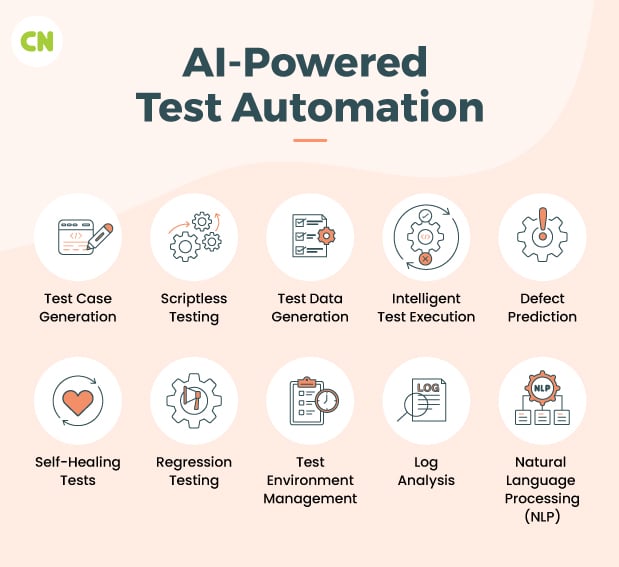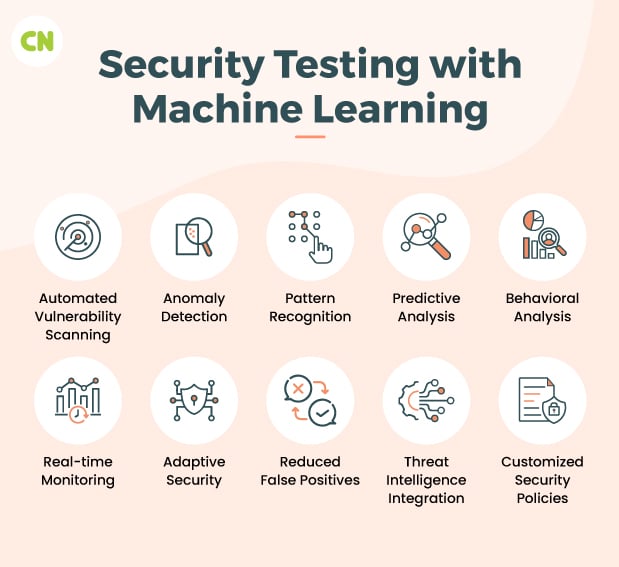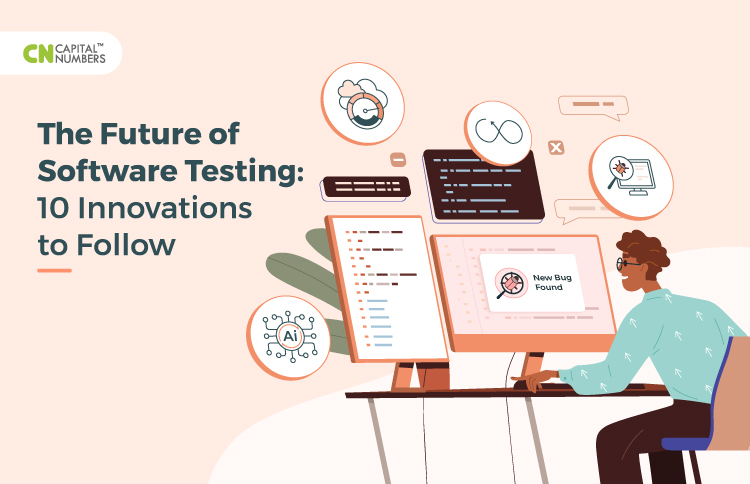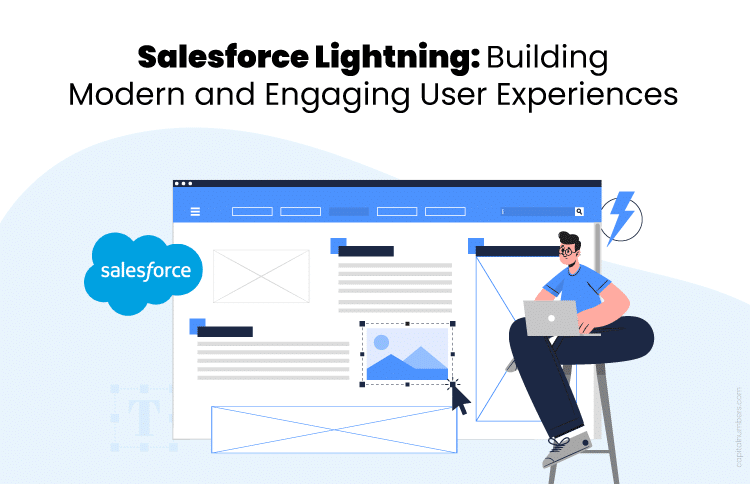The Future of Software Testing: 10 Innovations to Follow
Table of Contents
In this era of rapid digital transformation, businesses rely on software more than ever to deliver their services and products. Whether it’s a mobile app, a web application, or a complex enterprise software solution, ensuring its quality and reliability is paramount. However, traditional testing methodologies often fall short in speed and effectiveness. That’s where innovations in software testing come into play, offering fresh approaches and cutting-edge technologies to address these challenges.
Eager to uncover the latest innovations in software testing and discover how they are reshaping the way we ensure software quality and efficiency in a fast-paced, technology-driven world? Let’s dive in.
1 AI-Powered Test Automation

AI is transforming software development and testing. AI-powered test automation is an advanced approach that combines artificial intelligence (AI) and automation to streamline and enhance software testing processes.
Key aspects of AI-powered test automation include:
- Test Case Generation: AI algorithms can automatically generate test cases based on the application’s specifications, code, and historical data, reducing the manual effort required for test case design.
- Scriptless Testing: AI-driven tools enable scriptless testing, allowing testers to create and execute test cases without writing complex scripts, making it accessible to non-technical team members.
- Test Data Generation: AI can generate realistic and diverse test data, improving test coverage and thoroughly testing various scenarios.
- Intelligent Test Execution: AI algorithms prioritize and execute test cases based on risk assessment, critical functionality, and code changes, optimizing test coverage and efficiency.
- Defect Prediction: Machine learning models can predict potential defects by analyzing code changes and historical defect data, allowing proactive defect prevention.
- Self-Healing Tests: AI-powered test automation tools can automatically update test scripts to adapt to changes in the application’s user interface, reducing maintenance efforts.
- Regression Testing: AI automates regression testing by identifying areas of the application affected by code changes and executing relevant test cases.
- Test Environment Management: AI assists in setting up and managing test environments, ensuring consistency and reproducibility of tests.
- Log Analysis: AI tools analyze test logs and provide insights into defects, performance bottlenecks, and areas requiring further testing.
- Natural Language Processing (NLP): NLP-driven chatbots facilitate collaboration among testers, developers, and other stakeholders, improving communication and issue resolution.
AI-powered test automation enhances testing efficiency, reduces manual effort, and improves test coverage, making it an essential component of modern software development and quality assurance processes.
2 Shift-Left Testing
Shift-left testing is a software testing approach that emphasizes moving the testing process to earlier stages of the software development lifecycle (SDLC). Traditionally, testing occurs towards the end of the development cycle, but shift-left testing advocates for conducting testing activities as early as possible.
Key aspects of shift-left testing include:
- Early Involvement: Testers are involved in the project from the beginning, collaborating closely with developers, business analysts, and other stakeholders. This early involvement ensures that quality considerations are integrated into the requirements and design phases.
- Continuous Testing: Shift-left testing promotes continuous and iterative testing throughout development. Developers run unit tests to verify their code changes as they write them, while automated testing tools can validate code commits in real time.
- Automation: Test automation plays a crucial role in shift-left testing. Automated tests are created early and run frequently, allowing for rapid feedback and early detection of defects.
- Immediate Feedback: By testing early and often, issues are identified and resolved sooner, reducing the cost and effort required to fix defects discovered later in the SDLC.
- Parallel Activities: Shift-left testing doesn’t replace traditional testing phases but complements them. Activities like system testing and user acceptance testing still occur but with the advantage of having a more stable and higher-quality codebase.
Shift-left testing helps improve software quality, accelerate development cycles, and enhance collaboration among team members by promoting a culture of proactive quality assurance from the project’s outset.
3 DevOps and Continuous Testing:
Continuous testing is an integral part of the DevOps pipeline. It involves running automated tests continuously throughout the software development lifecycle (SDLC).
The key objectives of continuous testing are:
- Early Feedback: Continuous testing provides rapid feedback to development teams by detecting defects and issues early in development.
- Quality Assurance: It ensures that software changes do not introduce new defects or regressions and that existing functionality remains intact.
- Automation: Continuous testing relies on automated testing frameworks and tools to execute tests efficiently and consistently.
- Integration: Tests are tightly integrated into the CI/CD pipeline and automatically triggered whenever code changes occur.
- Validation: It validates that new features and code changes meet the desired quality and functionality criteria before production.
DevOps and continuous testing work hand in hand to accelerate software delivery, improve collaboration, and maintain high-quality software products. DevOps focuses on software development’s broader cultural and operational aspects, while continuous testing ensures that each code change is thoroughly tested to meet quality standards. They enable organizations to deliver software faster, more reliably, and more confidently.
4 Exploratory Testing with AI Assistance
Exploratory Testing with AI Assistance combines human creativity and expertise with artificial intelligence to enhance the testing process.
Key aspects of this approach include:
- Human Expertise: Testers use domain knowledge and intuition to explore the application without predefined test cases.
- AI Tools: AI-powered tools and algorithms assist testers by providing suggestions, detecting patterns, and automating repetitive tasks.
- Test Data Generation: AI can assist in generating test data, helping testers explore various scenarios.
- Faster Bug Discovery: AI identifies potential issues early in testing, allowing for quicker bug discovery and resolution.
- Test Case Evolution: Testers continually adapt and evolve their testing strategies based on AI-driven insights and test results.
- Coverage: Combining human exploration with AI ensures comprehensive test coverage, including edge cases.
- Feedback Loop: Continuous feedback and learning from AI tools improve the testing process over time.
- Risk Mitigation: AI assists in identifying high-risk areas, reducing the likelihood of critical issues in production.
This approach fosters a dynamic and adaptive testing process that leverages AI’s capabilities to uncover defects efficiently while utilizing human testers’ creativity and intuition to simulate real-world user interactions effectively.
5 Performance Testing in the Cloud
Performance testing in the cloud is a software testing approach that assesses the performance, scalability, and reliability of applications or systems using cloud computing resources. Key aspects of this methodology include:
- Cloud Infrastructure: Leveraging cloud service providers like AWS, Azure, or GCP to provision virtualized resources for testing.
- Types of Testing: Conducting various performance tests such as load testing, stress testing, scalability testing, latency testing, capacity testing, and endurance testing.
- Cost-Effectiveness: The pay-as-you-go model ensures cost control, as organizations pay only for the resources used during testing.
- Scalability: Easy resource scaling up or down to simulate diverse user loads and identify scalability bottlenecks.
- Global Testing: Access to data centers worldwide enables testing from different geographical locations, replicating real-world scenarios.
- Realistic Simulation: Accurate replication of real-world conditions, including user loads and network variations.
- Faster Setup: Rapid provisioning and configuration of cloud resources compared to traditional hardware.
Challenges include security and data privacy, resource management, network variability, and potential data transfer costs. Various cloud-based performance testing tools and platforms are available to facilitate test script creation, execution, and result analysis within cloud environments.
6 Security Testing with Machine Learning

Security testing with machine learning involves using AI and ML techniques to identify vulnerabilities and assess the security of software applications.
Key aspects of this approach include:
- Automated Vulnerability Scanning: ML algorithms automatically scan the application’s code and infrastructure to identify known vulnerabilities, such as common security flaws and outdated libraries.
- Anomaly Detection: Machine learning models establish a baseline of normal behavior and detect anomalies or suspicious activities within the application, helping identify potential security breaches.
- Pattern Recognition: ML algorithms analyze patterns in data traffic and user behavior to identify unusual patterns that may indicate cyberattacks or security threats.
- Predictive Analysis: Machine learning can predict potential security threats by analyzing historical data and trends, allowing proactive security measures to be taken.
- Behavioral Analysis: ML models monitor and analyze the behavior of users and systems to detect any deviations from expected behavior, flagging potential security risks.
- Real-time Monitoring: Machine learning enables real-time monitoring of security events, providing immediate alerts and responses to security incidents.
- Adaptive Security: ML systems continuously learn and adapt to new security threats, enhancing their ability to detect and mitigate evolving risks.
- Reduced False Positives: ML algorithms help reduce false positives by fine-tuning security alerts based on historical data and context.
- Threat Intelligence Integration: Integration with threat intelligence feeds enables ML systems to stay updated with the latest information on known threats and vulnerabilities.
- Customized Security Policies: Machine learning can assist in creating and customizing security policies based on an application’s specific needs and vulnerabilities.
Security testing with machine learning significantly improves the efficiency and effectiveness of security assessments by automating vulnerability detection, providing real-time threat monitoring, and adapting to emerging security threats. It enhances software development companies’ ability to protect their software and infrastructure from potential security breaches and cyberattacks.
7 IoT (Internet of Things) Testing
IoT (Internet of Things) testing is a specialized process designed to ensure the functionality, security, and reliability of IoT devices and applications. Key aspects of IoT testing include:
- Device Compatibility Testing: Ensure IoT devices work seamlessly with various platforms, operating systems, and communication protocols.
- Interoperability Testing: Check IoT devices can communicate and work together across different brands and models.
- Performance Testing: Evaluate the responsiveness, speed, and scalability of IoT applications, especially when dealing with many connected devices.
- Security Testing: Identify vulnerabilities in IoT devices and applications to prevent data breaches, unauthorized access, and other security risks.
- Data Integrity Testing: Verify the accuracy and integrity of data collected and transmitted by IoT devices.
- Usability Testing: Assess the user-friendliness of IoT applications and interfaces for end-users and administrators.
- OTA (Over-the-Air) Updates Testing: Verify the reliability and security of remote firmware updates for IoT devices.
IoT testing is essential to ensure the reliability and security of IoT ecosystems, as it involves a complex network of devices and applications that must work together seamlessly to deliver a positive user experience.
8 Blockchain Testing
Blockchain testing evaluates and verifies the functionality, security, and performance of blockchain networks and applications. Key aspects of blockchain testing include:
- Smart Contract Testing: Ensure that smart contracts and self-executing agreements on the blockchain function as intended and are free from vulnerabilities and bugs.
- Functional Testing: Verify that the blockchain network performs its core functions, such as transaction validation, consensus mechanisms, and data storage, correctly.
- Performance Testing: Assess the speed, scalability, and throughput of the blockchain network, especially when handling a high volume of transactions.
- Consensus Mechanism Testing: Evaluate the chosen consensus algorithm (e.g., Proof of Work, Proof of Stake) for its effectiveness, security, and efficiency.
- Node Testing: Test the various nodes in the blockchain network, including full nodes, light nodes, and miners, to ensure they operate correctly.
- Transaction Testing: Validate the integrity and correctness of transactions processed on the blockchain, including testing for transaction delays and failures.
Blockchain testing is critical to building trust in blockchain applications and networks, particularly in finance, supply chain, and healthcare industries, where security and reliability are paramount. Testing helps identify and address issues early in development, ensuring a robust and secure blockchain ecosystem.
9 Microservices Testing
Microservices testing is crucial to ensuring the reliability, functionality, and performance of microservices-based applications. Here are five key aspects of microservices testing:
- Service Isolation Testing: Microservices are designed to be isolated, independently deployable units. Each service should be tested in isolation to ensure it performs its designated functions correctly. Testing service isolation involves unit tests, component tests, and API tests specific to each microservice, verifying their internal logic and data processing.
- Integration Testing: Microservices interact with one another through APIs and external dependencies. Integration testing ensures that these interactions work as expected. It involves testing microservices’ communication and data exchange, validating that they can collaborate seamlessly.
- Contract Testing: Contract testing focuses on the agreements (contracts) between microservices. Contracts define the expected behavior of service interactions. With contract testing, you verify that microservices adhere to these contracts, ensuring that changes in one service do not break functionality in others.
- Load and Performance Testing: As microservices-based applications can scale horizontally, it’s crucial to perform load and performance testing to assess how well they handle increased workloads. This type of testing helps identify bottlenecks, assess resource utilization, and optimize microservices for optimal performance.
- Fault Tolerance and Resilience Testing: Microservices are expected to be resilient in the face of failures. Fault tolerance testing simulates various failure scenarios to ensure that microservices can recover gracefully. Testing fault tolerance includes scenarios like service unavailability, network failures, database outages, and more to confirm that the system remains operational.
Microservices testing also includes security testing, data consistency testing, and monitoring. The goal is to ensure that each microservice performs its role correctly and that the entire application functions cohesively. Comprehensive testing is essential to deliver reliable and resilient microservices-based applications.
10 Robotic Process Automation (RPA) Testing
Robotic Process Automation (RPA) testing for software involves ensuring the accuracy, reliability, and efficiency of RPA bots in automating business processes. Here are four key aspects of RPA testing for software:
- Functional Testing: Functional testing in RPA involves validating that the bots perform their intended tasks correctly. Test cases mimic real-world scenarios and assess the bot’s ability to interact with software applications, extract data, make decisions, and perform actions. The key aspects of functional testing include input validation, data extraction accuracy, workflow execution, and exception handling. It ensures that the bot’s actions align with the expected outcomes.
- Regression Testing: Regression testing is essential to ensure that any changes or updates to the RPA software do not introduce defects or disrupt existing functionalities. This testing confirms that previously automated tasks continue to work as expected after bot updates or changes in the software environment. Automated regression tests help maintain the stability and reliability of RPA bots over time.
- Performance Testing: Performance testing evaluates how efficiently RPA bots operate within the software environment. It measures response times, throughput, and resource utilization to ensure that bots can handle workloads effectively. Scalability testing is a subset of performance testing and assesses how well bots can accommodate increased tasks or processes without degradation in performance.
Comprehensive RPA testing for software helps organizations deploy reliable automation processes, enhance productivity, and reduce operational risks associated with automation.
Read More: Top 10 Must-Have Software Development Tools for Tech Companies
Final Thoughts
Innovations in software testing stand as the driving force behind higher-quality software products in today’s evolving digital landscape. As businesses increasingly rely on software to deliver their services, embracing these advancements is crucial to ensure the reliability, security, and performance of applications. Software testing enhances quality and improves efficiency by incorporating AI-powered test automation, exploratory testing with AI assistance, and other cutting-edge approaches.
Want to incorporate the latest software testing principles in your software development process? At Capital Numbers, we will ensure that your software projects follow the best security and quality standards. Whether you need web/mobile app testing, usability testing, regression testing, or something else, our expert professionals will cover you. Eager to discuss your project? Call us today!


 Web Development
Web Development Cloud Engineering
Cloud Engineering Mobile App Development
Mobile App Development AI/ML/GenAI
AI/ML/GenAI E-commerce
E-commerce Software Development
Software Development UI/UX
UI/UX QA
QA Dedicated Teams
Dedicated Teams











